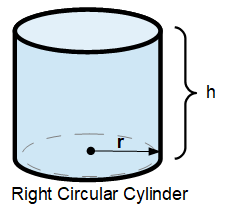Circular - Mass
The Circular Mass calculator computes the weight (mass) of a cylinder based on the radius (r) and height of the cylinder (h), and the density of the material (mD). NEW: Weight of Steel Cylinders using millimeters and density of steel.
INSTRUCTIONS: Choose units and enter the following:
- (h) Height
- (r) Radius of Base
- (mD) Mean Density of material
Circular Mass (m): The weight / mass is returned in kilograms, with the volume of the cylinder in cubic meters. However, these can be automatically converted to compatible units via the pull-down menu.
The Math / Science
The weight or mass of a right circular cylinder formula computes the mass of a right cylinder as a function of the mean density (mD) of the composition and the volume calculated using the radius (r) of the base and the height (h). The default results will be in kilograms but can be converted to any of the system provided units. The formula for the weight of a cylinder is:
Wt=[π⋅r2⋅h]⋅mD
where:
- Wt = weight of the cylinder
- r = radius of cylinder
- h = height of cylinder
- mD = mean density of the material in the cylinder.
The formula to compute the volume of the geometric shape based on the input parameters. Using the volume of a cylinder, the formula for mass from volume and density:
where:
- V is the volume
- mD is the mean density.
Mean Density Table
| Common Mean Densities in Kilograms per Meter Cubed (kg/m3) | ||
|
Fluids
Fuels
Market-Ready Grains |
Metals
|
Earthen
Synthetic
Organic
|
| Mean Density Lookup Function | ||
Mean density is scientifically volume divided by mass. There are various unit for density adopted by cultures and industries. Common units for density included the following:
- kilograms per cubic meter (kg/m3)
- grams per cubic centimeter (g/cm3)
- grams per liter (g/L)
- pounds per cubic feet (lb/ft3)
- ounces per cubic inch (oz/in3)
- pounds per barrel (lb/bbl)
- pounds per bushel (lb/bu)
If you want to identify a material by its density, use the Density Within Range tool.
Cylinder Calculators
- Cylinder Side Area: Computes the surface area of the sides of a cylinder based on height and radius.
- Cylinder Surface Area: Computes the total surface area of a cylinder including sides, top and bottom.
- Cylinder Volume: Computes the volume of a cylinder based on cylinder height and radius.
- Cylinder Volume from Height and Circumference: Computes the volume of a cylinder based on the height and circumference. It also returns the diameter of the cylinder.
- Cylinder Height: Computes the height of a cylinder based on the volume and radius.
- Cylinder Radius: Computes the radius and diameter of a cylinder based on the volume and height.
- Cylinder Weight: Computes the weight, mass and volume of a cylinder based on the height, radius and density.
- Cylinder Mass Computes the mass of a cylinder based on the radius and height and mean density of the cylinder.
- Volume in Horizontal Cylinder: Computes partial volume of a horizontal circular cylinder based on the radius and length of the cylinder and the vertical height of the contents in the cylinder (see diagram).
- Cylinder Density: Computes the mean density of a cylinder based on the mass and computed volume from the radius and height.
- Slanted Cylinder Surface Area: Computes the surface area of a slanted cylinder based on the radius and side length (L).
- Slanted Cylinder Area from Angle: Computes the lateral area (surface area of the sides) of a slanted cylinder based on its radius, height and slant angle (θ).
- Slanted Cylinder Volume: Computes the volume of a slanted cylinder based on the radius of the base, side length and slant angle.
- Slanted Cylinder Weight: Computes the weight or mass of a slanted cylinder based on the radius, side length, slant angle and density.
- Cylinder MoI about Central Axis: Computes the moment of inertia of a cylinder about its central axis based on the mass and radius.
- Cylinder MoI about the End: Computes the moment of inertia of a solid circular cylinder of uniform density about an axis along the diameter of the cylinder at one end.
- Cylinder MoI Perpendicular to Axis: Computes the moment of inertia of a solid circular cylinder of uniform density about an axis perpendicular to the axis of the cylinder and through the center of mass.
- Comments
- Attachments
- Stats
No comments |

